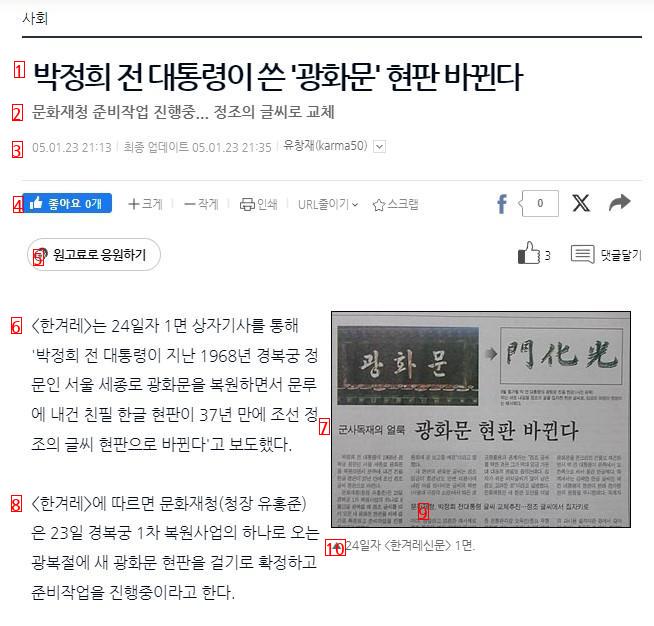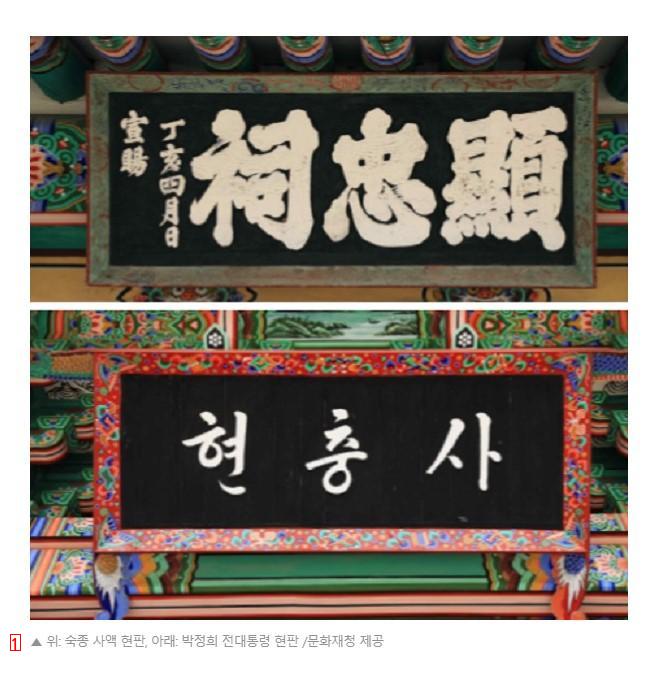
image text translation
(1)Culture CultureGeneral
(2)Yoo In-chon “Gwanghwamun signboard should be written in Korean”
(3)JoongAng Ilbo | Entered 2024.05.15 00:12
(4)Eunbin Kim Reporter
(5)Minister of Culture, Sports and Tourism Yoo In-chon delivers greetings at the ‘Sejong Ido Tanshin Ceremony’ in front of the Crystal Hall of Gyeongbok Palace in Seoul, South Korea, on Thursday, a day ahead of the 627th anniversary of King Sejong the Great’s nativity. Yonhap News Agency
(6)Culture, Sports, and Tourism Minister Yoo In-chon on the 14th, a day before the ‘627-stone King Sejong the Great Naked Day’
(7)”Personally, I think it (the Gwanghwamun sign) should be in Korean,” he said.
Did Yoo In-chon suddenly fall in love with Hangul?
But why does it hold on to the Gwanghwamun plaque and sag?
The reason for this is that the old Gwanghwamun sign was in Korean.

image text translation
(1)Concrete Gwanghwamun Plaque Ceremony Held in 1968 with the participation of major figures in Korea, including former President Park Chung-hee and others.
(2)Plaque ceremony. A plaque with Park’s handwriting hangs on the restored concrete Gwanghwamun Gate. The concrete Gwanghwamun Gate has been restoredSource: The Korea Times
(3)It was met with considerable criticism shortly thereafter and was quickly torn down. ttps://www.segye.com/newsView/2018022
Yes, in the past, Gwanghwamun was restored by Park Chung-hee with concrete rice cake.
The plaque was a plaque with his own handwriting on it.
The Gwanghwamun Gate has since had to be removed and restored at great expense.
The plaque is…

image text translation
(1)’Gwanghwamun’ plaque written by former President Park Chung-hee will be changed
(2)Preparations are underway for the Cultural Heritage Administration… Replace with Jeongjo’s writing
(3)05.01.23 21:13 Last updated 05.01.23 21:35 |Yoo Changjae(karma50) v
(4)0 likes +Large-Small | Print | Clip URL shortener
(5)Support with manuscript fees
(6)<"Former President Park Chung-hee restored the Gwanghwamun Gate, the main gate of Gyeongbokgung Palace, to Sejong-ro in Seoul in 1968, and the handwritten Korean plaque on the gate was replaced with a plaque of the Joseon Dynasty for the first time in 37 years," Hankyoreh reported in a front-page box article on the 24th.
(7)The stain of military dictatorship Gwanghwamun plaque changed
(8)According to
(9)President Park Chung-hee sleeps in the jungle
(10)
Amid a fierce backlash from far-right conservatives
I had to work hard to bring down Park Jung-hee Hyun-pan
I was able to restore Jung’s font.
This was accomplished during the Roh Moo-hyun presidency, when Yoo Hong-joon was head of the Cultural Heritage Administration.
Yes.
Far-right conservatives don’t want to see this.
Now, let’s restore Park Jung-hee’s Hangul version.
The Korean hangeul plaque that Yoo Yoo-chon was talking about is definitely Park Jung-hee’s plaque, not another plaque.
Didn’t they throw away Park’s plaque?
No way.
During the Park Geun-hye administration, an official from a powerful organization even called the museum and told them to “keep it safe.”
To this day, the Gwanghwamun plaque written by former President Park is still kept in the archives of the National Palace Museum.
And to talk a little bit more about Park’s inspiration for his writing…
The most prominent example of him scribbling all over the place is
An example is the plaque at the Asan County War Memorial in Chungcheongnam-do.

image text translation
(1)Top: Sookjong’s plaque, bottom: plaque of former President Park Chung-hee/Courtesy of Korea Cultural Heritage Administration
Hyeonchungsa Temple originally has a plaque that Sookjong resigned when Hyeonchungsa Temple was built in 1707.
However, the regime’s legitimacy is based on the fact that it has increased the number of veterans and
The real war memorials are in the back of the old main building.
In the place you put up as the new main building
Park Chung-hee publishes the book in his own handwriting in 1967.
In this regard, Mr. Choi Sun-sun, a member of General Yi Sun-sin’s family, demanded the removal of the plaque of Park Jung-hee.
The Cultural Heritage Administration ignores it, saying that Shin Hyeonchungsa Temple is the work of Park Jung Hee, and that its history and unity should not be damaged.
Of course, there’s also the
Peg
There were, and still are, a lot of signs.
The current plaque of Hwaseokjeong (Gyeonggi-do Tangible Cultural Property No. 61) in Paju-si, Gyeonggi-do,
Unhankak, Hwaryeongjeon (Historic Site No. 115 – Jeongjo’s shrine), Suwon-si, Gyeonggi-do, Korea, – (replaced in 2008 by calligrapher Jeong Jeong-joon’s inscription)
Plaque on the Yeonghoru Building in Andong, Gyeongbuk, Korea
A plaque at Haengjusanseong (Historic Site No. 56) in Goyang-si, Gyeonggi-do, Korea,
The Sejongjeon Exhibition Hall (an exhibition of Sejong’s artifacts) and the Hunminmun Gate plaque in Yeongneung, Yeoju-gun, Gyeonggi-do (Historic Site No. 195),
A plaque of Munsungsa (Shrine of Munsung – Yulgok Yi) in Ojukheon (Treasure No. 165), Gangneung-si, Gangwon-do,
A plaque in Hahoe Village, Andong City, Gyeongbuk,
A plaque at the Yuksinsa Shrine (Shrine of the Four Yuksins), built in the Suncheon Park clan’s home village in Dalseong-gun, Daegu,
Incheon Ganghwa-do Battlefield Monument for the Renovation and Purification of the Incheon Ganghwa-do Battlefield.
Park’s chisel is also embedded like a stake in places that are not national treasures, treasures, or historic sites.
‘Samilmun’, the main gate of Topgol Park on Jongno 2-ga, Jongno-gu, Seoul, changed the letters of the Declaration of Independence into Chinese characters.
The Chinese character plaque of the Liberation Gate (National Treasure No. 50) of Dogapsa Temple in Wolchulsan Mountain, Yeongam-gun, Jeollanam-do, was changed to the writing style of Lee Kwang-sa in the late Joseon Dynasty.
Statue of General Yi Sun-sin on Sejong-ro, Jongno-gu, Seoul,
Suwon Farmers’ Center, the birthplace of the Saemaul movement,
‘Unification Road’ monument at the head of Unification Road in Gupabal, Eunpyeong-gu, Seoul,
The ‘Muakjae’ monument, erected while expanding the Hongjedong to Independence Gate road in Seoul, is one of the most famous examples.
It is still in the handwriting of Sal.Sackmar Park Jung-hee.
Now that we’re going to bring back those stakes, we’re going to use the
Isn’t this the plan of the gentrifiers and the far right?
For some reason, I was thinking about the Koreanization of the Gwanghwamun signboard by Yoo In-chon.